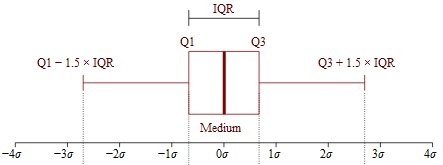Descriptive Statistics > Interquartile Mean
You may want to read this article first: What is the trimmed mean?
What is the Interquartile Mean?
The interquartile mean (IQM) is the mean of the middle 50 percent of data in a data set. Unlike the “regular” arithmetic mean, it is resistant to outliers.

How to Find the Interquartile Mean
The calculation is different depending on if your data is divisible by 4 or not.
Data is Divisible by Four
Example question: Find the IQM for the following data set:
5 6 17 30 44 55 56 8 9 11 13 15 1 3 16 65
Step 1: Sort the data from smallest to largest:
1 3 5 6 8 9 11 13 15 16 17 30 44 55 56 65
Step 2: Discard the bottom 25% and top 25% of numbers. In other words, split the data set into quarters and remove the top and bottom quarters:
1 3 5 6 | 8 9 11 13 | 15 16 17 30 | 44 55 56 65
Step 3: Find the mean of the remaining numbers:
(8 + 9 + 11 + 13 + 15 + 16 + 17 + 30 ) / 8 = 14.875
That’s it!
Data is NOT Divisible by Four
Example question: Find the IQM for the following data set:
6 17 30 44 55 56 8 9 11 13 15 1 3 16 65
Step 1: Sort the data from smallest to largest:
1 3 6 8 9 11 13 15 16 17 30 44 55 56 65
Step 2: Divide the number of items in the set by four. The set has 15 items, so 15/4 = 3.75.
Step 3: Remove the whole number (Step 2) from the bottom and the top of the set. For this example, the whole number is 3 (from 3.75):
1 3 6 8 9 11 13 15 16 17 30 44 55 56 65
which leaves:
8 9 11 13 15 16 17 30 44
Step 4: Figure out how many items are in the interquartile range. The IQR is the middle two quarters, so there would be 3.75 * 2 = 7.5 numbers.
Step 5: Place parentheses around the middle set of numbers using the whole number from Step 4. In this example, the whole number is 7:
8 (9 11 13 15 16 17 30) 44
Step 6: Take the fractional part from Step 4 (.5 in this case) and divide it by two (because there are two numbers on the outside of the parentheses):
.5/2 = .25
This means that the numbers 8 and 44 will each contribute 25% to the IQM.
Step 7: Multiply the two “outside” numbers (8 and 44 in this case) by the fraction in Step 6:
8 * .25 = 2
44 * .25 = 11
Step 8: Replace the two outside numbers by the fractional numbers (Step 7) and find the mean. When dividing by “n”, use the number of items in the IQR from Step 4 (7.5 in this case), not the actual number count (9 in this example):
82 (9 11 13 15 16 17 30) 4411 =
(2 + 9 + 11 + 13 + 15 + 16 + 17 + 30 + 11)/7.5 = 16.53.
That’s it!
References
Salkind, N. (2008). Encyclopedia of Research Design. SAGE.